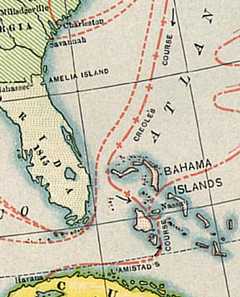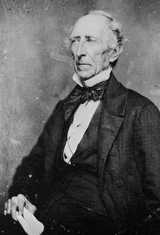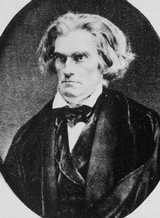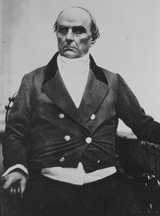 map from A. B. Hart, 1906
map from A. B. Hart, 1906
|
The American brig Creole sailed in October 1841 from Hampton Roads, Virginia, with 135 slaves bound for New Orleans. On Nov. 7, as the ship approached the Bahamas, the ship's chief mate found the slave cook, Madison Washington, in the main hold with the female slaves. Washington ran up to the deck, resisted the attempts of the chief mate to seize him, and called on the other slaves to join his resistance. Led by Washington and 3 other slaves, a total of 19 slaves participated in taking over the brig, subduing the crew, and forcing William Merritt, the white overseer, to steer the ship into Nassau, a British port in the British colony of the Bahamas. One white man had been killed by the slaves when his musket failed to fire and one black slave would later die of wounds. According to international law, the slave revolt on this ship was a mutiny, not piracy, and fell under the jurisdiction of the local authority where the crime occurred. The Creole arrived in Nassau Nov. 9 and British authorities imprisoned the 19 slave revolt participants. The remainder of the slaves were taken off the brig by local residents who surrounded the ship in their small boats and demanded that the British grant freedom to the slaves. With all slaves removed, the brig set sail and arrived in New Orleans Dec. 2.
 President John Tyler
President John Tyler
|
The reaction throughout the South was outrage at the British for interfering in America's lawful coastal trade. The case seemed similar to another slave ship, the Spanish-owned Amistad, that had been transporting 53 slaves captured illegally in Africa from Havana to another Cuban port in 1839 when Cinque led a revolt and the ship ended up in Connecticut. The Supreme Court ruled that the slaves should be freed because Spain had outlawed the African slave trade in 1820. But in the case of the Creole, the slaves were legally purchased in Virginia and were being legally transported to another American port. The British in Nassau ruled that local laws applied to the Creole, and since the British Emancipation Act of 1833 ended slavery in the British empire, the Creole slaves were free. The British had also freed slaves in previous cases of the American ships Comet, Encomium, Enterprise, and Formosa that had been driven ashore or wrecked in the islands.
The Creole became part of the widening attack on slavery by northern abolitionists in the 1842. Madison Washington was portrayed as a romantic hero in a New York Evangelist newspaper story titled "The Hero Mutineers" and emphasized "his generous leniency towards his prisoners" because he restrained his fellow rebels from killing the crew and "dressed the wounds of the poor sailors who had fought against him."
 John C. Calhoun
John C. Calhoun
|
Elizur Wright said "the hand of God is in this matter" as it was in the Amistad revolt, and men like Cinque and Washington were the chosen divine agents of God. William Goodell noted that the Creole revolt occurred on the very same day as the death of abolitionist martyr Elijah Lovejoy in Alton, Illinois on Nov. 7, 1837. John Quincy Adams led a campaign to present petitions to Congress to end slavery, and Joshua Giddings introduced resolutions that praised the Creole rebels and argued that the slave codes of the southern states had no jurisdiction on the high seas. Giddings also attacked the gag rule in the House that had prohibited discussion of slavery (in effect 1836-44), was censured by the House March 22, 1842, resigned from Congress but returned by special election in April.
Secretary of State Daniel Webster was seeking to resolve the northeast boundary dispute with Britain in 1842 and wanted to avoid a crisis over the Creole. He agreed with the Robert Peel ministry that the 19 slaves imprisoned in Nassau should not be tried for murder or mutiny because the revolt had taken place outside local jurisdiction, nor should the slaves be sent to America because England had no extradition treaty with the United States (the Jay's Treaty provision for extradition had expired in 1807).
 Daniel Webster 1850,
Daniel Webster 1850,
by Southworth & Hawes
|
Therefore, Madison Washington and the 18 other slave rebels were set free in Nassau. Webster did demand some compensation from Britain for the loss of property sustained by the slaveowners. When Lord Ashburton came to the U.S. to negotiate the Webster-Ashburton Treaty, he agreed to refer the issue back to England for settlement. He offered the assurance that British authorites would avoid "officious interference" with ships brought into British ports. He also added an extradition agreement to the Webster-Ashburton Treaty. Article 10 allowed extradition for seven crimes: "murder, or assault with intent to commit murder, or piracy, or arson, or robbery, or forgery, or the utterance of forged paper." There was no mention of mutiny or slave revolt, and extradition would not be used against any of the 12,000 ex-slaves who had fled to Canada. Southerners were agreeable to this Anglo-American compromise, but northern abolitionists were opposed and angry at Webster for compromising on the issue of slavery. The U.S. navy joined the British navy to enforce the African slave trade prohibition, but the British did not interfere in the coastal slave trade. In 1855, a claims commission awarded $110,330 in compensation from the British government payable to the owners of the Creole slaves.
revised 2/9/2000 by Schoenherr | Creole